As I recover from my total knee replacement operation (five weeks now -and going well so far hopefully, thank you), every morning my attention is drawn to this sight outside my kitchen window. I know as a responsible farmer I should not allow this guy even to exist, but no-one is perfect – and it is so cute and may soon succumb to some awful disease anyway, alas. (The blackberry also craves my attention – birds love our garden and the neighbours love weeds).
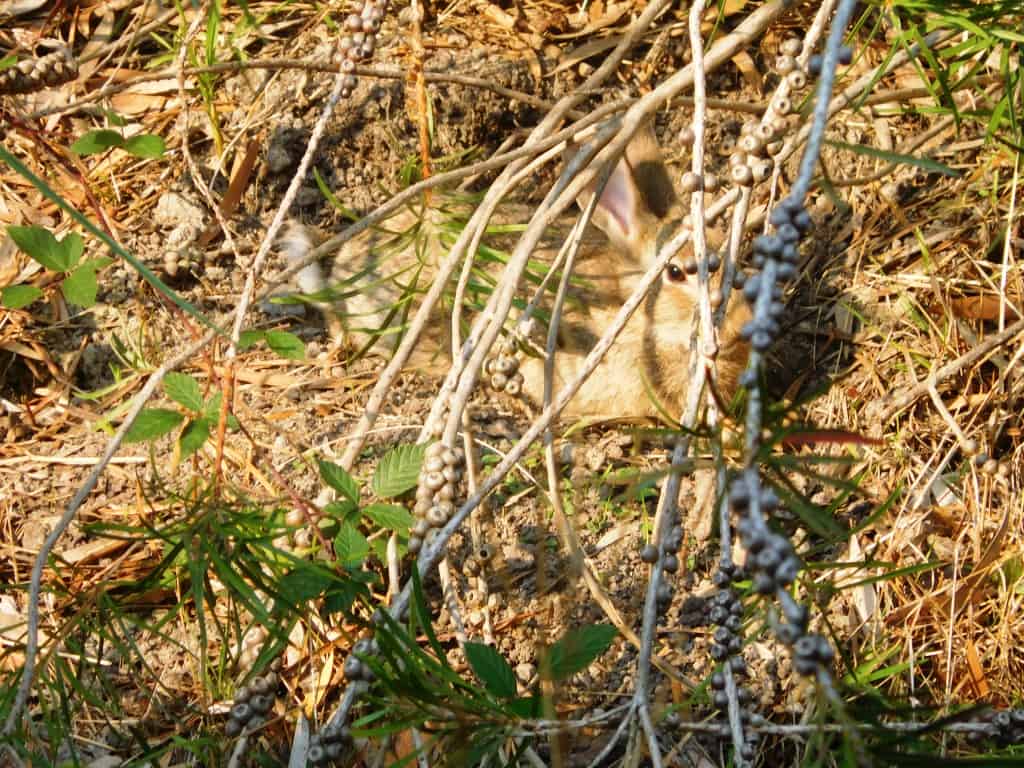
NB If you took a second or two to see the rabbit (I would have seen it instantly) it is because you are not ‘looking through’ but ‘looking at’. This is the most important hunting skill, and the first you must master.
He first cleans himself diligently, then lies in the sun on his tummy like that for over an hour every morning on a little platform he has constructed under a shrub on the slope behind the house not ten metres from the kitchen window. This is a well-established habit.
All creatures fall into a pattern of such habits – even human beings. A moment’s refection of your daily routines will cause you to admit that you are no different in this than your wild brethren. The successful hunter can utilise careful observation and such recurring habits to ensure success in harvesting nature’s annual bounty for the table.
And that is what responsible hunting is – it is not pest management. Its goal is not the eradication of some undesirable feral species but the careful nurture and management of a noble creature and desirable food source. Just as a farmer (such as me) manages his flocks to ensure that they increase and multiply each year (and are healthy and content) to the maximum extent of the available food source so that in autumn when that food supply begins to decline they will be sent off to market for the benefit of other people’s tables rather than slowly starve as the lean times of winter hit. This is nature’s cycle.
So too the hunter each year takes the annual ‘production’ of his/her chosen ‘block’, weeds out unsatisfactory animals and ensures that a healthy herd is provided for – basically in perpetuity.
In these posts Ultralight Hiking #102 and The Importance of Landmarks (and others – follow/explore the links) I explained how first to learn to find your way in the bush by (repetitively) exploring a delimited area until you were confident you had learned the skills of wilderness navigation so that you could then venture out into the wider unrestricted wilderness. You will then have gone on to explore and ‘claim’ a number of favourite hunting areas as your ‘own’.
‘Mine’ are usually a day’s walk or more from car access so that I feel that they are much more ‘mine’, and that others are less likely to harvest the animals which I am observing – and caring for. Also I am more likely to be alone and undisturbed – which I like. If you plan to spend a few day’s camping well away from your vehicle (perhaps your motorcycle or e-bike) which you may even have concealed away from prying eyes, it will be desirable if you have paid attention to how to lighten your load in the many ways I have explained in this blog such as The Ultralight Deer Hunter and Ultralight Ultracheap Deer Hunting and a Ripping Yarn or Two.
The first time you visit an area you will spend much more time studying sign so that your eyes will be focused more on the ground (and so not seeing the deer through the trees – as I have explained many times how to do, as in Sambar Deer Hunting #101 for example). I am imagining you might have a dozen or so favourite areas which you know well, and that you will add or delete new/old ones as the years pass. There is a joy in exploring new country but there is also a delicious sense of deja vu in revisiting old haunts.
Your first and early visits are all about understanding the habits of the resident deer. With a little bit of intelligence, keen observation and experience this ought not be too hard to do. Deer are (as are many herbivores) largely crepuscular and nocturnal creatures ie they like to feed in the twilight and dimmer light when they perceive their dangers are least and their relative advantages of sense, flight and survival are greatest. (For example, you will seldom see a deer if that day’s night that has a full moon).
Consequently you will see their tracks coming and going (usually by slightly different routes) to and from their favourite feeding ‘grounds’, and observe their progression through the various areas where they feed. They are, as we all are, creatures of habit. You could just about time them, as with us.
If you find as many tracks as this,there are obviously a lot of deer about. Some places there are 200 deer per square kilometre.
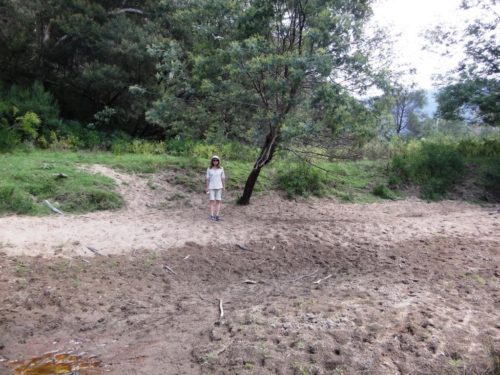
On their way to their feeding grounds and on their return they have favourite spots they visit for various cervine purposes (rubs, wallows, preaching trees etc), then they have a number of places where they like to ‘lie up’, changing them sometimes during the day as the sun moves so that they stay warm or cool as the need requires. Then also there are their drinking and mothering/nursery areas, etc. As you will be (probably) following their tracks on early visits you should discover where all these spots are for any particular herd/group.
Sometimes you will find cast antlers in wallows.
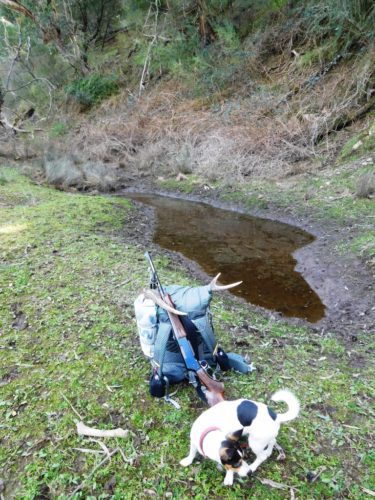
A ‘preaching tree’ might look like this:
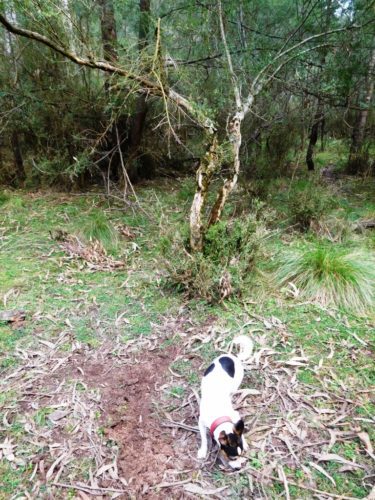
You will also certainly find just such artificially enhanced small flat ‘bedding’ spots as the rabbit in the photo is employing. Remember to look there again! You will learn the time when Bambi is ‘home’.
On those early visits you might not see many deer as you are too intent on looking for sign (close up), whereas the deer are aware of you at a greater distance as they are always looking (at the lay of the land) through the trees and will see you (early) and most often just slink off, sometimes if you startle them awake giving a few warning barks/honks before they do.
Every now and then you will come across a particularly inept deer who will have allowed you to approach very close before s/he notices you who will (probably) rise up very fast, honk very loudly and crash off most precipitously, most likely too fast for you to get a shot off – unless you use a lever action with open sights as I do.
Sometimes there will be one who is even dozier who stands around stupidly, or who will actually lie asleep whilst you (inadvertently) step over them (thinking perhaps they are a log. Yes I have) who will wake up whilst you are doing so and pitch you head over heels in the bush as they do so. This has happened to me a number of times! This is a disadvantage of focusing too far away.
After you have ‘mastered’ the rhythms of a particular area you will ‘know’ where the deer will be at different times of the day, and perhaps different seasons – particularly important for success is where they ‘bed’ in inclement weather. This is the hardest thing to learn. It is also important to ‘know’ the patterns of their movements as sometimes the ground is too hard to leave good marks or they may have been washed out by heavy rain overnight.
Now, you will be able to quietly just ‘go’ to where you expect the deer to be, and hopefully s/he will be there. After a while you will recognise just the ‘type’ of area they will be in (in new country) and just be able to head straightaway to the most likely spots. I do this relatively unerringly now.
You should be looking through the bush to see something like this:
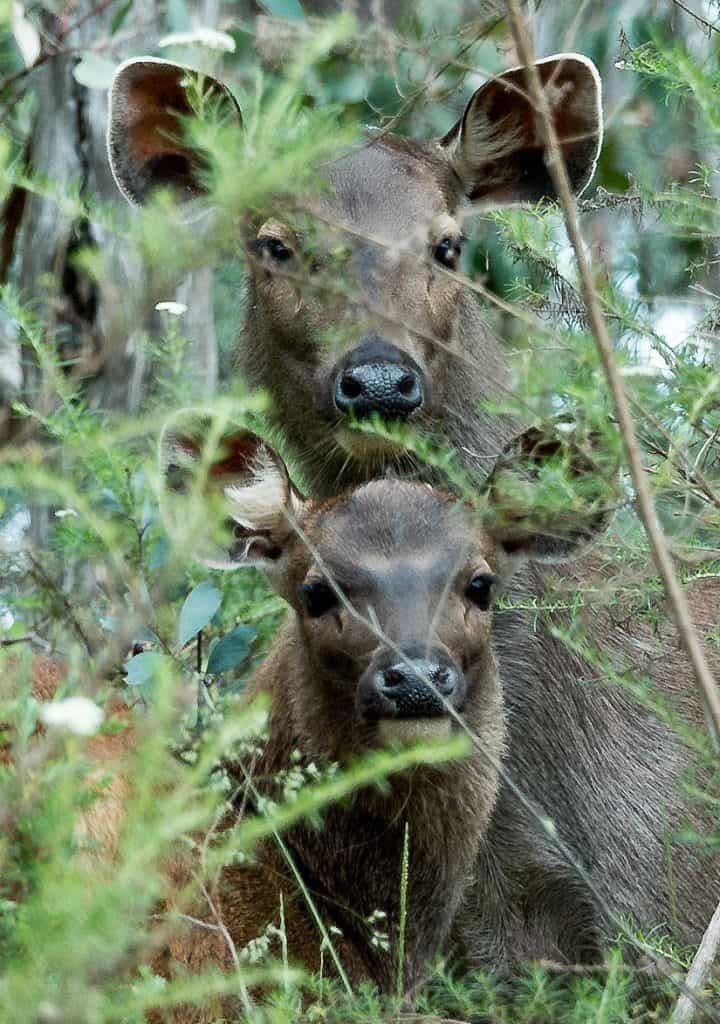
After many years of experience (for me) this is usually the case, so that I mostly see around a dozen deer in a day’s walking in the bush. These days I almost never shoot a single one – as at nearly 75 it is enough to carry myself and my few possessions there without lugging large bits of dead deer all the way back to my car, – and probably foreshortening a trip I wish to relish as well.
Besides I have been a sheep farmer for over fifty years, so we have plenty of delicious (lamb) meat already in the freezer to eat. I really don’t need deer hunting as an excuse to be out in the bush, but I still enjoy it, so why not do it?
There will obviously be deer around in a fine grassy gully such as this – as additionally evidenced by the rub line.
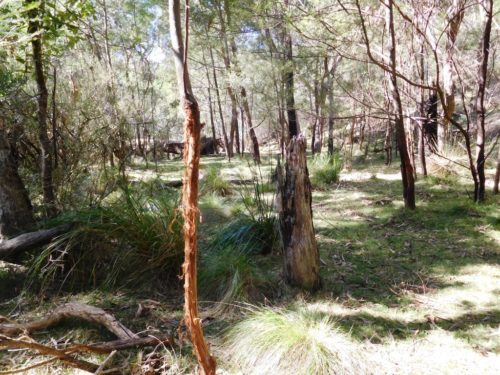
Once you are seeing lots of deer you can just enjoy seeing them, learning more about them and learning to ‘love’ them more and more, or you can ‘chose’ which ones you will harvest – and when. It is not all that advisable to always plan to ‘take’ the largest stag possible, for example. Firstly he will almost certainly not taste all that great, from my experience. Sometimes indeed, if he is ‘in the rut’ he will be well-nigh inedible. The meat will have an awful rank odour even months later when it is thawed out from the freezer, bad enough you may want to throw it away. Yes, really. Though apparently some people adore these strong flavours.
He may also be somewhat tough too compared with a younger doe or spiker. He is also needed (as compared with lesser males) to maintain the high quality of the herd. Strength, size, muscling, vigour. Good antler growth.
It is better for the herd to cull the lesser animals, particularly badly formed ‘heads’ in stags or does in poor condition etc. You may also not want to take does which are heavily pregnant (as evidenced by the size and shape of their bellies – a particularly gravid shape is quite revealing and easy to spot) or if they are clearly in the early stages of lactation and have dependent young at foot – so avoid ‘nursery’ areas except for observation – which is interesting. If you are very quiet you will learn that deer do have many different (soft) articulations there.
You should not take more than you need. Others should be able to enjoy the annual harvest too, and we (surely) all want a herd which will sustain hunting into the future. Too much of what is happening at the present is culling or pest management. This includes the dreadful helicopter and poisoning operations undertaken by government departments, wilful ‘over-hunting’ by some hound crews – also often hunting in ‘no-go’ areas with too many dogs and etc, etc such as in the post The Silence of the Deer.
I am mostly appy to just watch the deer go by and admire their beauty:
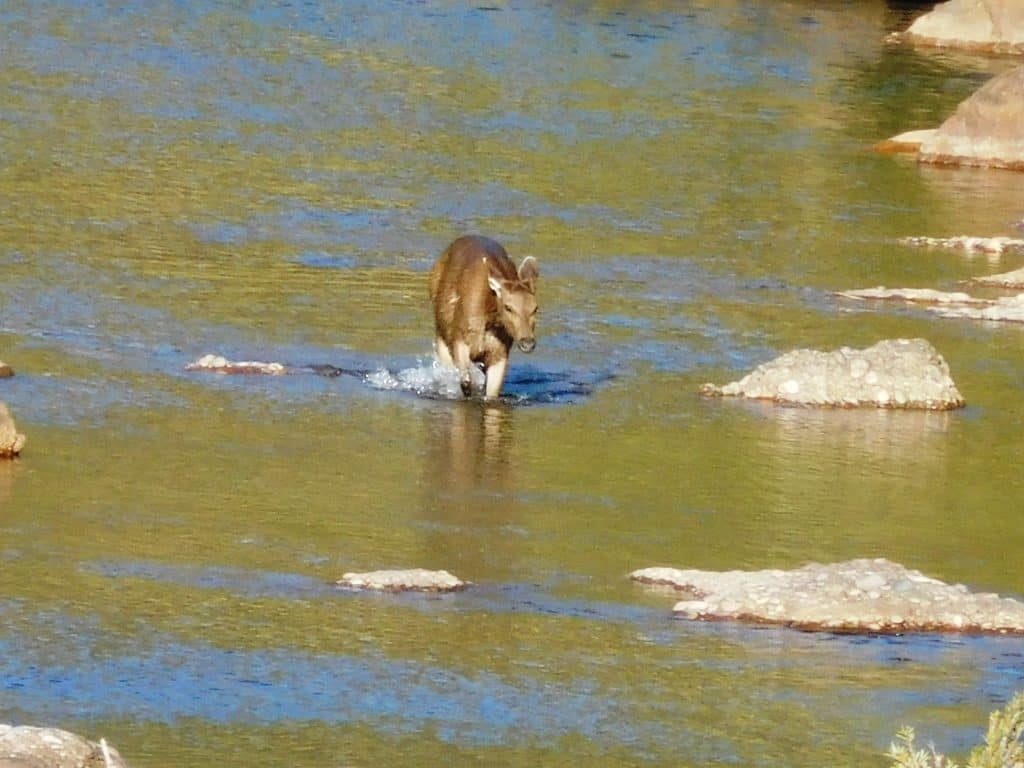
More and more I also see (as a member of a number of deer ‘hunting’ ‘forums’ or ‘chat groups’) that people are eagerly shooting deer along roadsides, at night and in open paddocks then posting photos of themselves (their ‘triumphs’, in camo – as if that was needed for such misbehaviour) with the poor animals.
Any damned fool can see that this is what they have been doing as the background/topography clearly reveals that the animal was not hunted or shot deep in the bush but along a roadside or right in the middle of a paddock (often in the middle of the day – you can tell by the light – oh sure!)
Some people are also inordinately proud of having taken an excess of deer. This is just wantonness and greed. I have said before I knew years ago a stalker who could (and did – for demonstration purposes) shoot 9-10 deer a day. He returned with their fresh tails in his backpack as proof, so there could be no doubt, and if one listened one could hear him from time to time knock one over far off in the bush. One an hour at least in thick bush.
Having encountered this person I then realised that I had much to learn about deer hunting and subsequently learned it, so that I could if I wished do just what he was doing – and I can, but I do not. I am not a deer culler, nor should you be unless you are employed specifically for that purpose. The deer herd is a hunting resource for all and for subsequent generations and needs to be carefully nurtured, maintained and improved for that purpose.
I have said before you do not need camo or telescopic sights and my opinion is that they should not be employed at all, ever – except by cullers. The deer deserves to be able to employ his or her own native advantages – their senses and ability to move about quickly and energetically. Shooting a deer at a distance from a hide over telescopic sights or from the concealment of camouflage is just an obscenity. Give the deer a fair chance. And a chance to see you. Ideally you should have to take him with hand tools – spears, knives, bows and arrows where s/he has the maximum ability to escape and evade pursuit and death, and to employ his or her own weapons/defences against you if s/he so chooses.
When you spot a family of sambar lying under a tree cooling off like this it would be just too easy to op one (or two) of them off from a distance with a telescopic sight – but try walking up to 50-100 metres away and see how well you do.
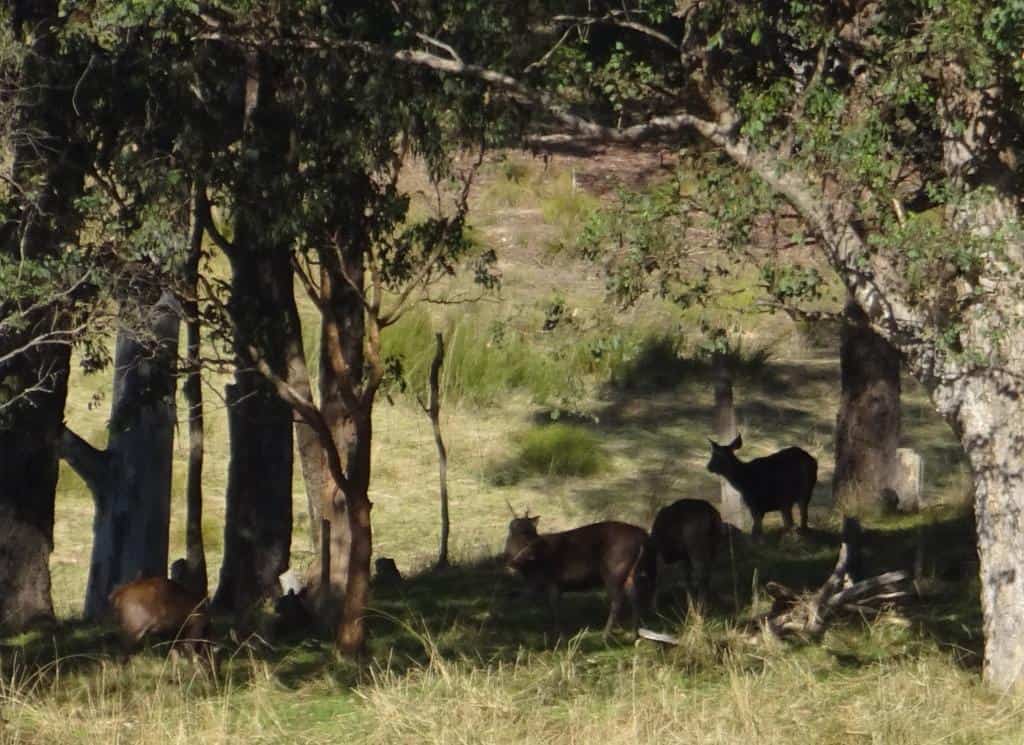
Hpwever Sir Samuel Baker managed to take over 400 of these creatures with only an 18″ knife in C19th Ceylon, running through the bush after them in order to do so. When I was (very) much younger I too was often able to keep up with the hounds and even sometimes arrive where the deer was at bay even before they did.
I could have dispatched them then with a spear (or less safely) with a knife many, many times. No gun at all. Back then. Oh, to be young again! But it is also very, very good to be old. You have to realise that well more than two-thirds of the people I have ever known have now pre-deceased me. Yet I, I regret nothing.
And I go on. Maybe rather slowly and (to you) maybe falteringly, but even with a very wounded knee I was dragging myself off into the forest, just for the sheer enjoyment (even with the pain) as in this recent post, A River Somewhere, and now that my knee is all fixed (though it will never be as it once was), I will be away again over this winter (I hope) to revisit some old haunts and explore a few new ones. You will hear about some of those adventures in time.
A late friend of mine (years ago) Arthur Meyers once leapt onto the back of a stag he was pursuing in this way, seizing it by the antlers with the intention of dispatching it with his Bowie knife. This is a true story. He actually succeeded (with a mature sambar stag!) though evidently he was somewhat the worse for wear and vowed never do essay to do so again! They threw away the mould when they made Arthur, as the saying goes.
I am not insisting that you pursue every deer on foot and dispatch it with your bare hands or your pocket knife. But you should at least pursue it on foot and shoot it over open sights at not more than 100 paces – and with a single killing shot! And as I said, take only what you need – and do take it.
Some people seem to think that the sambar have reproduced to the extent that the resource is well-nigh unlimited and that they need to be pursued as if they were a pest animal which urgently needed eradicating. Such an attitude will lead to just that in time, ie their eradication, one way or another.
Already their numbers have dropped significantly in some areas I hunt. We must eradicate such an attitude instead. The herd needs to be actively managed so as to benefit itself and the needs of future generations of hunters. Where there are too many we need to be more active, where there are too few a little more patient. Where it is forbidden to hunt (for obscure bureaucratic reasons) such as large parts (still) of the Alpine National Park (and in NSW etc), we must lobby to have that changed, rather than have this precious resource culled and wasted.
See Also:
and the links below it and below other links above in the main article.
Happy hunting, Steve.
